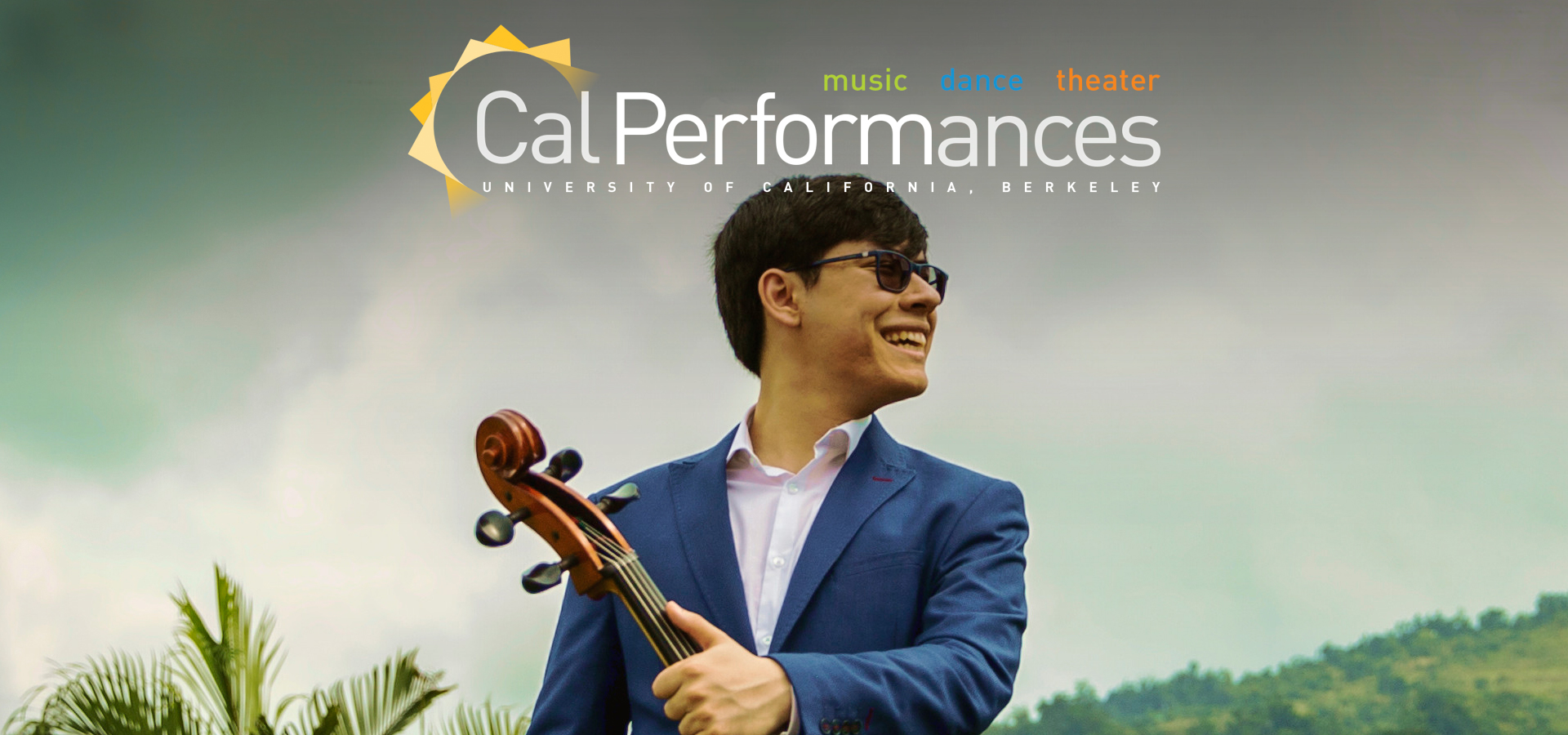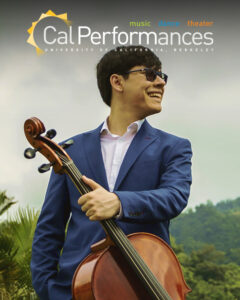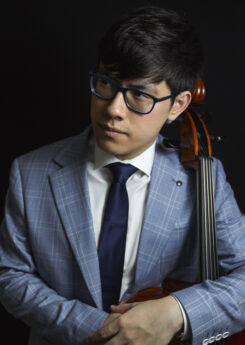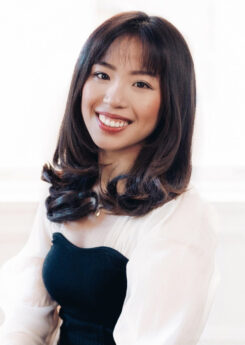Zlatomir Fung, cello
Janice Carissa, piano
Sunday, November 20, 2022, 3pm
Hertz Hall
Support for Zlatomir Fung is provided by Fred Levin, The Shenson Foundation.
Run time for this concert is approximately 90 minutes, including intermission, but not including any possible encores.
From the Executive and Artistic Director
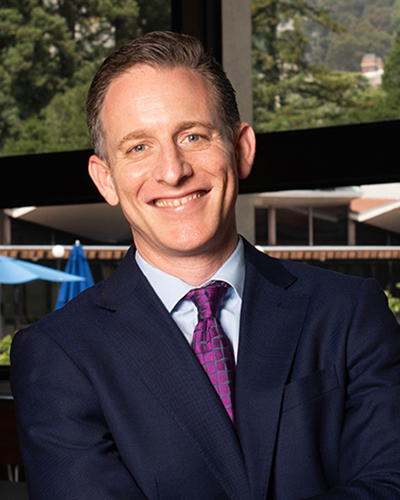
This month, Cal Performances’ 2022–23 season shifts into high gear! Our carefully curated, season-long Illuminations programming (see below for details) continues with visits from new-music champions the Colin Currie Group (with Synergy Vocals) and Sō Percussion, and our classical music offerings are distinguished by appearances by acclaimed soprano Ying Fang (with pianist Ken Noda), early-music superstars (and Berkeley favorites!) Jordi Savall and his renowned Hespèrion XXI ensemble, and an astonishing young talent, cellist Zlatomir Fung (with pianist Janice Carissa). We’ll also enjoy a special Vocal Celebration, with three concerts honoring the otherworldly beauty of Georgian polyphony (Ensemble Basiani), the inspirational power of freedom songs from both South Africa and the United States (Soweto Gospel Choir), and—in a joyous launch of the upcoming holiday season—the heart-warming sounds that spring from Austria’s august six-century-old choral tradition (Vienna Boys Choir).
But this is just the start! From now until May 2023—when we close our season with the Bay Area premiere of Octavia E. Butler’s powerful folk opera Parable of the Sower and a highly anticipated recital with international dramatic soprano sensation Nina Stemme—we have a calendar packed with the very best in the live performing arts.
And what a schedule! More than 70 events, with highlights including the return of the legendary Vienna Philharmonic Orchestra under conductor Christian Thielemann (in his Bay Area debut); the beloved Mark Morris Dance Group in Morris’ new The Look of Love: An Evening of Dance to the Music of Burt Bacharach; the US premiere of revered South African artist William Kentridge’s astonishing new SIBYL; and a special concert with chamber music superstars pianist Emanuel Ax, violinist Leonidas Kavakos, and cellist Yo-Yo Ma. And these are only a few of the amazing performances that await you!
Illuminations programming this season will take advantage of Cal Performances’ unique positioning as a vital part of the world’s top-ranked public university. In the coming months, we’ll be engaging communities on and off campus to examine the evolution of tools such as musical instruments and electronics, the complex relationships between the creators and users of technology, the possibilities enabled by technology’s impact on the creative process, and questions raised by the growing role of artificial intelligence in our society.
This concept of “Human and Machine” has never been so pertinent to so many. Particularly over the course of the pandemic, the rapid expansion of technology’s role in improving communication and in helping us emotionally process unforeseen and, at times, extraordinarily
difficult events has made a permanent mark on our human history. Throughout time, our reliance on technology to communicate has—for better and worse—influenced how we understand others as well as ourselves. During this Illuminations season, we will investigate how technology has
contributed to our capacity for self-expression, as well as the potential dangers it may pose.
Some programs this season will bring joy and delight, and others will inspire reflection and stir debate. We are committed to presenting this wide range of artistic expression on our stages because of our faith in the performing arts’ power to promote empathy. And it is because of our audiences’ openness and curiosity that we have the privilege of bringing such thought-provoking, adventurous performances to our campus. The Cal Performances community wants the arts to engage in important conversations, and to bring us all together as we see and feel the world through the experiences of others.
Please make sure to check out our brochures and our website for complete information about upcoming events. We can’t wait to share all the details with you, in print and online.
Welcome back to Cal Performances!
Jeremy Geffen
Executive and Artistic Director, Cal Performances
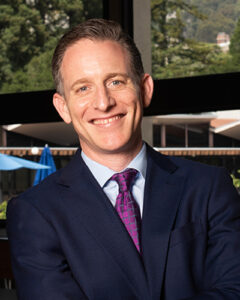 This month, Cal Performances’ 2022–23 season shifts into high gear! Our carefully curated, season-long Illuminations programming (see below for details) continues with visits from new-music champions the Colin Currie Group (with Synergy Vocals) and Sō Percussion, and our classical music offerings are distinguished by appearances by acclaimed soprano Ying Fang (with pianist Ken Noda), early-music superstars (and Berkeley favorites!) Jordi Savall and his renowned Hespèrion XXI ensemble, and an astonishing young talent, cellist Zlatomir Fung (with pianist Janice Carissa). We’ll also enjoy a special Vocal Celebration, with three concerts honoring the otherworldly beauty of Georgian polyphony (Ensemble Basiani), the inspirational power of freedom songs from both South Africa and the United States (Soweto Gospel Choir), and—in a joyous launch of the upcoming holiday season—the heart-warming sounds that spring from Austria’s august six-century-old choral tradition (Vienna Boys Choir).
This month, Cal Performances’ 2022–23 season shifts into high gear! Our carefully curated, season-long Illuminations programming (see below for details) continues with visits from new-music champions the Colin Currie Group (with Synergy Vocals) and Sō Percussion, and our classical music offerings are distinguished by appearances by acclaimed soprano Ying Fang (with pianist Ken Noda), early-music superstars (and Berkeley favorites!) Jordi Savall and his renowned Hespèrion XXI ensemble, and an astonishing young talent, cellist Zlatomir Fung (with pianist Janice Carissa). We’ll also enjoy a special Vocal Celebration, with three concerts honoring the otherworldly beauty of Georgian polyphony (Ensemble Basiani), the inspirational power of freedom songs from both South Africa and the United States (Soweto Gospel Choir), and—in a joyous launch of the upcoming holiday season—the heart-warming sounds that spring from Austria’s august six-century-old choral tradition (Vienna Boys Choir).
But this is just the start! From now until May 2023—when we close our season with the Bay Area premiere of Octavia E. Butler’s powerful folk opera Parable of the Sower and a highly anticipated recital with international dramatic soprano sensation Nina Stemme—we have a calendar packed with the very best in the live performing arts.
And what a schedule! More than 70 events, with highlights including the return of the legendary Vienna Philharmonic Orchestra under conductor Christian Thielemann (in his Bay Area debut); the beloved Mark Morris Dance Group in Morris’ new The Look of Love: An Evening of Dance to the Music of Burt Bacharach; the US premiere of revered South African artist William Kentridge’s astonishing new SIBYL; and a special concert with chamber music superstars pianist Emanuel Ax, violinist Leonidas Kavakos, and cellist Yo-Yo Ma. And these are only a few of the amazing performances that await you!
Illuminations programming this season will take advantage of Cal Performances’ unique positioning as a vital part of the world’s top-ranked public university. In the coming months, we’ll be engaging communities on and off campus to examine the evolution of tools such as musical instruments and electronics, the complex relationships between the creators and users of technology, the possibilities enabled by technology’s impact on the creative process, and questions raised by the growing role of artificial intelligence in our society.
This concept of “Human and Machine” has never been so pertinent to so many. Particularly over the course of the pandemic, the rapid expansion of technology’s role in improving communication and in helping us emotionally process unforeseen and, at times, extraordinarily
difficult events has made a permanent mark on our human history. Throughout time, our reliance on technology to communicate has—for better and worse—influenced how we understand others as well as ourselves. During this Illuminations season, we will investigate how technology has
contributed to our capacity for self-expression, as well as the potential dangers it may pose.
Some programs this season will bring joy and delight, and others will inspire reflection and stir debate. We are committed to presenting this wide range of artistic expression on our stages because of our faith in the performing arts’ power to promote empathy. And it is because of our audiences’ openness and curiosity that we have the privilege of bringing such thought-provoking, adventurous performances to our campus. The Cal Performances community wants the arts to engage in important conversations, and to bring us all together as we see and feel the world through the experiences of others.
Please make sure to check out our brochures and our website for complete information about upcoming events. We can’t wait to share all the details with you, in print and online.
Welcome back to Cal Performances!
Jeremy Geffen
Executive and Artistic Director, Cal Performances
About the Artists
The “Musical Mandate” of Groundbreaking Cellist Zlatomir Fung
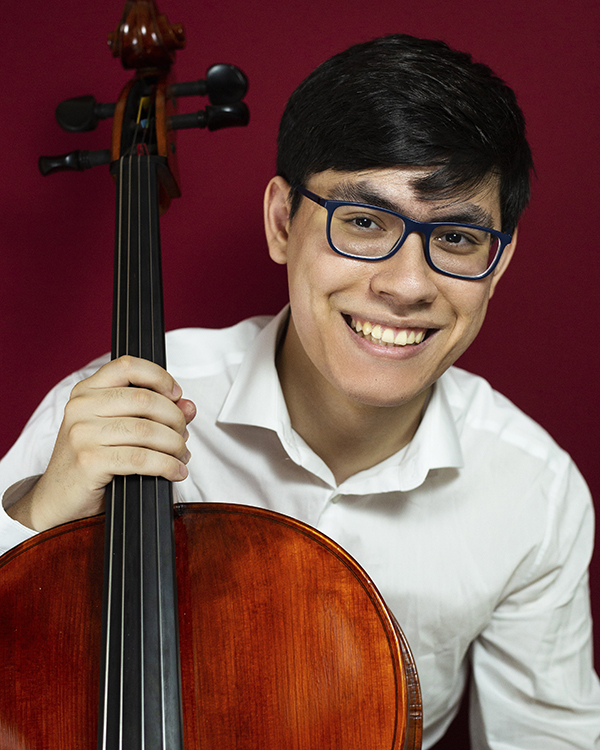
At 23 years old, cellist Zlatomir Fung has won international recognition for his profound musicianship. Over the past few years, he has made history as the youngest (age 20) musician, and first American in four decades, to win First Prize at the International Tchaikovsky Competition (Cello Division); he has received the Borletti-Buitoni Trust Fellowship and an Avery Fisher Career Grant; and he has toured in the United States, Europe, and Asia with renowned orchestras and as a recitalist. This Sunday (November 20), Fung offers the Bay Area an exciting opportunity to experience his virtuosity firsthand as he makes his Cal Performances debut.
Equally noteworthy to his 2019 victory at the Tchaikovksy competition are the nearly two decades of extreme dedication and attentiveness to his craft that preceded and enabled this particular accomplishment. Fung began playing the cello at age three and, showing early promise as a thoughtful and natural musician, participated in his first competition at only 11 years old.
“From the beginning, the most important aspect of the competition was my relationship with my progress and motivation,” said Fung. “As a very goal-oriented individual, competitions gave me a strong sense of purpose and focus for my improvement as a musician.”
As reported by Musical America, Fung’s attachment to the cello flourished substantially around this time. When he moved with his family to Boston at age 12, he was newly inspired by the local musical scene and began for the first time to seriously consider a career as a musician. With the change of scenery came fresh opportunities for deepened engagement, including enrollment in a New England Conservatory prep school program. As he fantasized about a future performing on grand concert stages, his fascination with great artists such as Edgar Moreau motivated him to build and refine his craft.
Fung continued competing into high school, earning prestigious awards that included top prizes at the 2016 George Enescu International Cello Competition, 2015 Johansen International Competition for Young String Players, 2014 Stulberg International String Competition, and 2014 Irving Klein International Competition. He was also recognized as a 2016 US Presidential Scholar for the Arts and earned the 2016 Landgrave von Hesse Prize at the Kronberg Academy Cello Masterclasses.
In 2017, he went on to study cello performance at the Juilliard School under the mentorship of Richard Aaron and Timothy Eddy. It was at the end of his second year at Juilliard that Fung competed in the 2019 International Tchaikovsky Competition, one of the most important international classical music competitions, which is held every four years to reward and reveal new talent among musicians ages 16 to 32 (cello division).
Though he was already something of a musical sensation at the time, Fung’s record-breaking win was a game-changer for his career, “open[ing] several doors… regarding personal connections, publicity, and international exposure,” he shared.
Following this win, requests for recital engagements from performing arts presenters rapidly increased, and Fung was faced with the challenge of balancing schoolwork with both music competitions and performances. Though a transition from competitions to recitals often happens more gradually and later in a performer’s career, for Fung, the overlapping engagements have proven a natural complement to one another.
“In many competitions I competed in, recital rounds were an essential part of the experience. They also happened to be my favorite part: I had more control over the repertoire and the possibility of crafting a varied experience for the audience and the jury,” Fung said. “My mentality during competitions and my mentality in other performances and recitals are mostly the same [in that] I strive to create the most immersive and transporting musical experience possible for the audience.”
This “immersive experience,” which serves as a hallmark of Fung’s performances, is well-documented, and speaks to his technical mastery as well as his acute interpretations and artful programming. The young artist has been described as having a “rare… Midas touch: he quickly envelops every score he plays in an almost palpable golden aura” (Bachtrack). Fung has also been lauded for his “impeccable intonation and thoughtful phrasing” (Baltimore Sun), which create a richness of performance likened to “his own musical mosaic” (Benicia Herald).
Ahead of his Cal Performances debut, Cal Performances Executive and Artistic Director Jeremy Geffen shared his own excitement about the opportunity to host Fung. “Introducing the next generation of artists Cal Performances’ audiences didn’t yet know they couldn’t live without has been a hallmark of our series for decades,” said Geffen. “Though we’re always excited to support artists on their ascent, I am particularly thrilled to present Zlatomir Fung, an artist in whom virtuosity, intelligence, preternatural emotional maturity, interpretive insight, and the ‘x factor’ all find their nexus!”
Fung is admittedly “particularly passionate about programming” and, though a true lover of classical repertoire, creates layers of meaning by pairing canonic pieces with newer works. For his Cal Performances recital, Fung has crafted an eclectic and engaging program that matches cello showpieces by Beethoven and Dvořák with an arrangement of Ives songs and two contemporary works: Judith Weir’s Unlocked, which was inspired by American folk songs, many of which were contributed by Black prisoners in Southern jails, and a cello sonata with distinct blues sonorities by George Walker, the first Black composer to win a Pulitzer Prize for Music.
Of his meticulously crafted programs, Fung said, “I enjoy bringing lesser-known works together with staples from the repertoire. The ability to shape the arc of an entire concert experience—a whole afternoon or evening with an audience—lends recitals a more authorial feel and gives [me] space to create an entire world for the audience to fall into.”
Though Fung greatly appreciates the “tremendous honor” of his past competition awards, he is ultimately focused on the “larger musical mandate,” and the opportunities afforded—particularly through recitals—to shape our relationship to important works.
“The awards are only the beginning,” Fung said. “The actual work and meaning lie in the art itself. As a young musician starting out, I want to bring an energetic, exuberant, and original voice to my work. One day, I hope to have done enough meaningful musical work to make my awards only a footnote in my biography.”

Equally noteworthy to his 2019 victory at the Tchaikovksy competition are the nearly two decades of extreme dedication and attentiveness to his craft that preceded and enabled this particular accomplishment. Fung began playing the cello at age three and, showing early promise as a thoughtful and natural musician, participated in his first competition at only 11 years old.
“From the beginning, the most important aspect of the competition was my relationship with my progress and motivation,” said Fung. “As a very goal-oriented individual, competitions gave me a strong sense of purpose and focus for my improvement as a musician.”
As reported by Musical America, Fung’s attachment to the cello flourished substantially around this time. When he moved with his family to Boston at age 12, he was newly inspired by the local musical scene and began for the first time to seriously consider a career as a musician. With the change of scenery came fresh opportunities for deepened engagement, including enrollment in a New England Conservatory prep school program. As he fantasized about a future performing on grand concert stages, his fascination with great artists such as Edgar Moreau motivated him to build and refine his craft.
Fung continued competing into high school, earning prestigious awards that included top prizes at the 2016 George Enescu International Cello Competition, 2015 Johansen International Competition for Young String Players, 2014 Stulberg International String Competition, and 2014 Irving Klein International Competition. He was also recognized as a 2016 US Presidential Scholar for the Arts and earned the 2016 Landgrave von Hesse Prize at the Kronberg Academy Cello Masterclasses.
In 2017, he went on to study cello performance at the Juilliard School under the mentorship of Richard Aaron and Timothy Eddy. It was at the end of his second year at Juilliard that Fung competed in the 2019 International Tchaikovsky Competition, one of the most important international classical music competitions, which is held every four years to reward and reveal new talent among musicians ages 16 to 32 (cello division).
Though he was already something of a musical sensation at the time, Fung’s record-breaking win was a game-changer for his career, “open[ing] several doors… regarding personal connections, publicity, and international exposure,” he shared.
Following this win, requests for recital engagements from performing arts presenters rapidly increased, and Fung was faced with the challenge of balancing schoolwork with both music competitions and performances. Though a transition from competitions to recitals often happens more gradually and later in a performer’s career, for Fung, the overlapping engagements have proven a natural complement to one another.
“In many competitions I competed in, recital rounds were an essential part of the experience. They also happened to be my favorite part: I had more control over the repertoire and the possibility of crafting a varied experience for the audience and the jury,” Fung said. “My mentality during competitions and my mentality in other performances and recitals are mostly the same [in that] I strive to create the most immersive and transporting musical experience possible for the audience.”
This “immersive experience,” which serves as a hallmark of Fung’s performances, is well-documented, and speaks to his technical mastery as well as his acute interpretations and artful programming. The young artist has been described as having a “rare… Midas touch: he quickly envelops every score he plays in an almost palpable golden aura” (Bachtrack). Fung has also been lauded for his “impeccable intonation and thoughtful phrasing” (Baltimore Sun), which create a richness of performance likened to “his own musical mosaic” (Benicia Herald).
Ahead of his Cal Performances debut, Cal Performances Executive and Artistic Director Jeremy Geffen shared his own excitement about the opportunity to host Fung. “Introducing the next generation of artists Cal Performances’ audiences didn’t yet know they couldn’t live without has been a hallmark of our series for decades,” said Geffen. “Though we’re always excited to support artists on their ascent, I am particularly thrilled to present Zlatomir Fung, an artist in whom virtuosity, intelligence, preternatural emotional maturity, interpretive insight, and the ‘x factor’ all find their nexus!”
Fung is admittedly “particularly passionate about programming” and, though a true lover of classical repertoire, creates layers of meaning by pairing canonic pieces with newer works. For his Cal Performances recital, Fung has crafted an eclectic and engaging program that matches cello showpieces by Beethoven and Dvořák with an arrangement of Ives songs and two contemporary works: Judith Weir’s Unlocked, which was inspired by American folk songs, many of which were contributed by Black prisoners in Southern jails, and a cello sonata with distinct blues sonorities by George Walker, the first Black composer to win a Pulitzer Prize for Music.
Of his meticulously crafted programs, Fung said, “I enjoy bringing lesser-known works together with staples from the repertoire. The ability to shape the arc of an entire concert experience—a whole afternoon or evening with an audience—lends recitals a more authorial feel and gives [me] space to create an entire world for the audience to fall into.”
Though Fung greatly appreciates the “tremendous honor” of his past competition awards, he is ultimately focused on the “larger musical mandate,” and the opportunities afforded—particularly through recitals—to shape our relationship to important works.
“The awards are only the beginning,” Fung said. “The actual work and meaning lie in the art itself. As a young musician starting out, I want to bring an energetic, exuberant, and original voice to my work. One day, I hope to have done enough meaningful musical work to make my awards only a footnote in my biography.”


